This weekend CBC Sports broadcast the ICF World Flatwater Championships from Szeged, Hungary. The broadcast was not live — competition was held the weekend before — but that's about the only complaint I can come up with about the coverage. Commentators Scott Russell and Scott Logan did a very good job putting things in context. They made a few factual slip-ups, but you would have to be a real know-it-all to point those out. Best of all, we got to see every final Canada was in — two and a half hours in all.
The local organizing committee should also be commended for giving the championship some good exposure. There were two things that I wanted to mention in particular. The first was the use of some unusual camera angles during the races. There was one mobile overhead camera in particular that gave a few fabulous shots from right on top of the boats. It provided some very dynamic views of the athletes as they passed by during the races.
The second item that was very cool was the event web site. If you go to the Results page and click on "Download Full Results," you can download a CD Image file of all of the race results — heats, semis, and finals, including all of the finish photos. The .iso file can be burned onto a CD and you will then have a web-browser-ready database of all of the race results.
Speaking of race results, there were lots of interesting things that happened at the World Championships this year. I won't talk too much about the Canadian team results, except to say congratulations to the team and all you sports fans should be ashamed of yourselves for the attention you don't give our amateur athletes.
Kidding, I'm kidding. But since I have all those results on CD now, let me try to dig something interesting out of the data. Specifically, I wanted to take a look at the influence that the wind conditions had on some of the races, since that point was raised a few times by Russell and Logan during the broadcast.
Flatwater canoe-kayak races are seeded from the middle out, just like swimming races and athletic sprints. The course has nine lanes, and the (nominally) fastest crews are put in the middle lanes, with the (nominally) slower boats in the outside lanes. When everything works properly, you get a photo finish that looks like this:
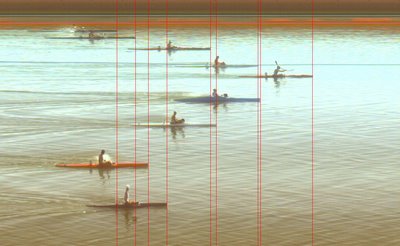
In Szeged, lane 1 is furthest from the judges' tower, at the top of the photo, and lane 9 is closest, at the bottom. If we look at the ensemble of all races at the World Championships, including preliminary rounds, we can see that the seeding is generally pretty good:
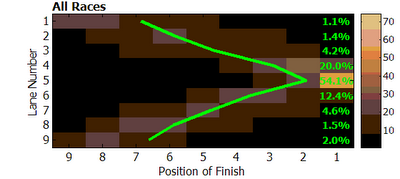
This picture is arranged to mimic the photo finish above; position of finish goes from first place on the right, to ninth place at left, and the lanes go from 1 at the top to 9 at the bottom. The brightness of the image at each point represents the percentage of competitors racing in each lane who finished in each position. The green numbers on the right-hand edge show the percentage of competitors in each lane who finished first in their race. The green curve shows the average position of finish for each lane (1-9) for all 220 races.
You might wonder exactly how this seeding works. For the first round of races, known as heats, competitors are seeded based on prior season results (World Cups etc.). As you can imagine, this is not really an exact science, but the people who do the ranking are pretty effective. Seeding for the semifinals is based on performance in the heats, so the athletes self-seed themselves for the second round. That works even better:
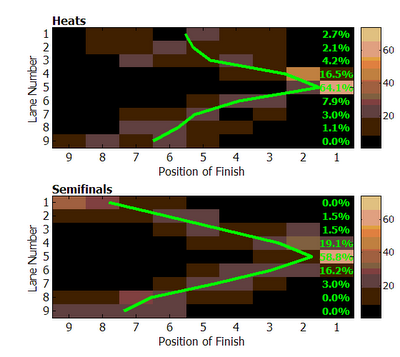
In this picture, the top image includes the 103 heats, and the bottom image shows the 68 semifinals. You can see that the seeding in the heats and semifinals is a very good predictor of performance. In these preliminary rounds, more than 60% of winners come from lane 5, and only a few from lanes 1, 8, or 9.
In fact, over two and a half days and 171 races, there wasn't a single winner from lane 9. And then came the afternoon of Saturday, August 19.
The finals don't go quite as strongly according to seed as the preliminary rounds, even when everything goes right. That's because the separation between the fastest and slowest paddlers shrinks when you get to the final. It's also because the seeding has a random component to it. For example, in men's K-1 there are four semifinals, and the winners go into the four middle lanes; only one of them can have lane 5, and that selection is made in a pseudo-random manner so that athletes can't easily choose their lane for the final.
But on average, you would still expect my probability diagrams to be fairly symmetric around lane 5, even if they're not as strongly peaked as they are for the semis. The upper image in the plot below shows the statistics for the 33 finals held on Sunday, August 20 (all 500 m and 200 m finals). I wasn't there in person, but from the broadcast it looked like pretty ideal conditions on Sunday — flat calm or slight headwind. There is not a strong asymmetry in the expected position of finish, which supports the idea that the wind conditions were fair.
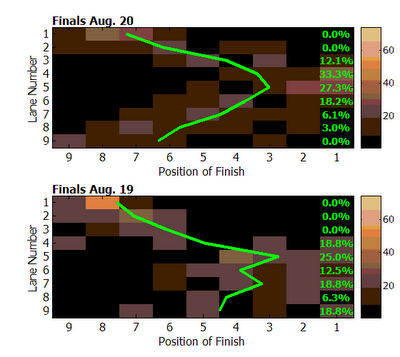
On Saturday afternoon, though, it was pretty clear that some lanes were better than others. The lower plot shows the statistics for the 16 finals (A and B finals) held on Saturday afternoon. As you can see, the distribution of finishes was significantly altered. Competitors in the near lanes had enhanced performances relative to competitors in the far lanes. There were even three winners out of lane 9, one in a 'B' final and two in championship finals.
From the broadcast it appeared that there was a significant cross-headwind during the 1000 m finals. Again, it's difficult to assess the conditions from the pictures on TV, but the statistics seem to show a pretty clear advantage for the high-numbered lanes, where the Szeged course is more sheltered by the shore and the grandstand. My point here is not to make excuses for anybody, nor to discount the two world championships earned by paddlers in lane 9. Canoe-kayak is not like swimming, where most environmental factors can be rigorously controlled. That's just the nature of our sport; sometimes the conditions work in your favour, sometimes they work against you, and hopefully most of the time it's neutral.
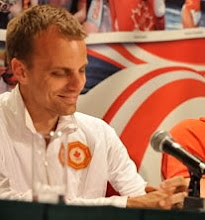

No comments:
Post a Comment